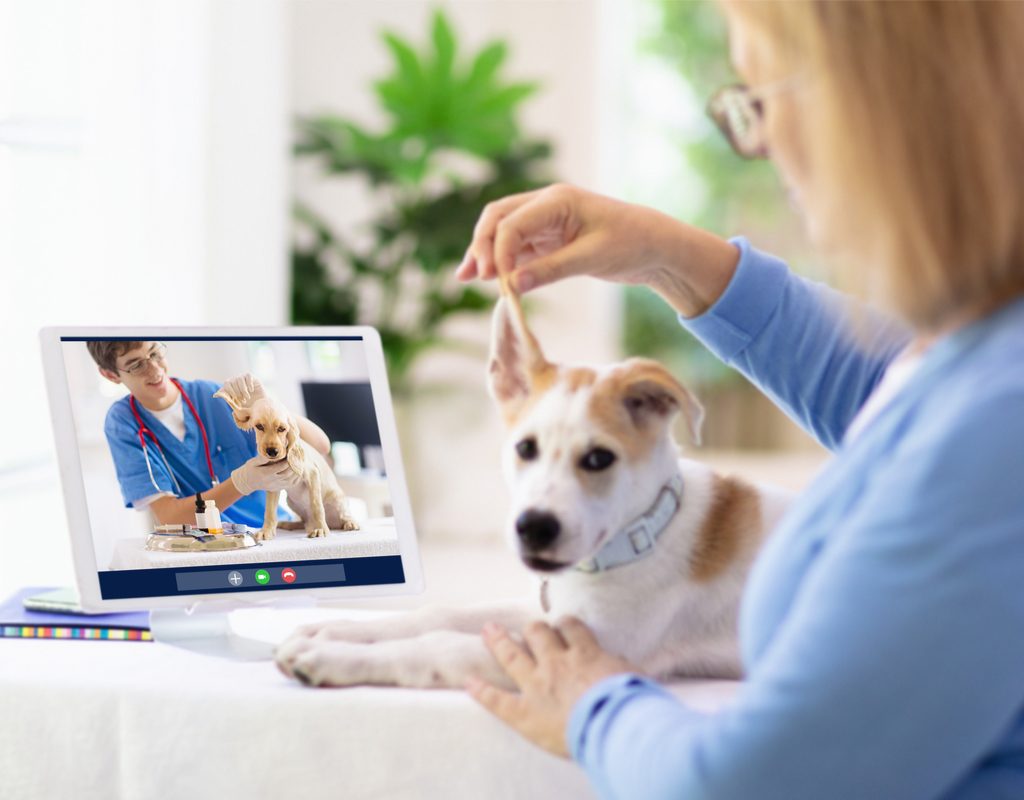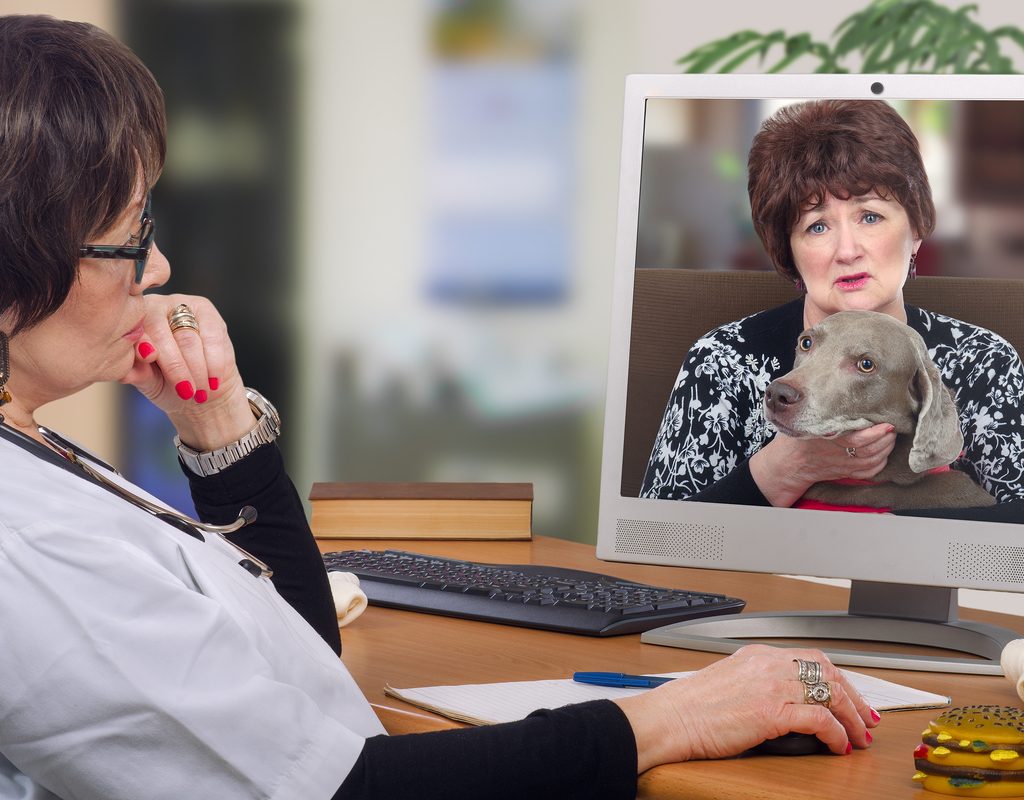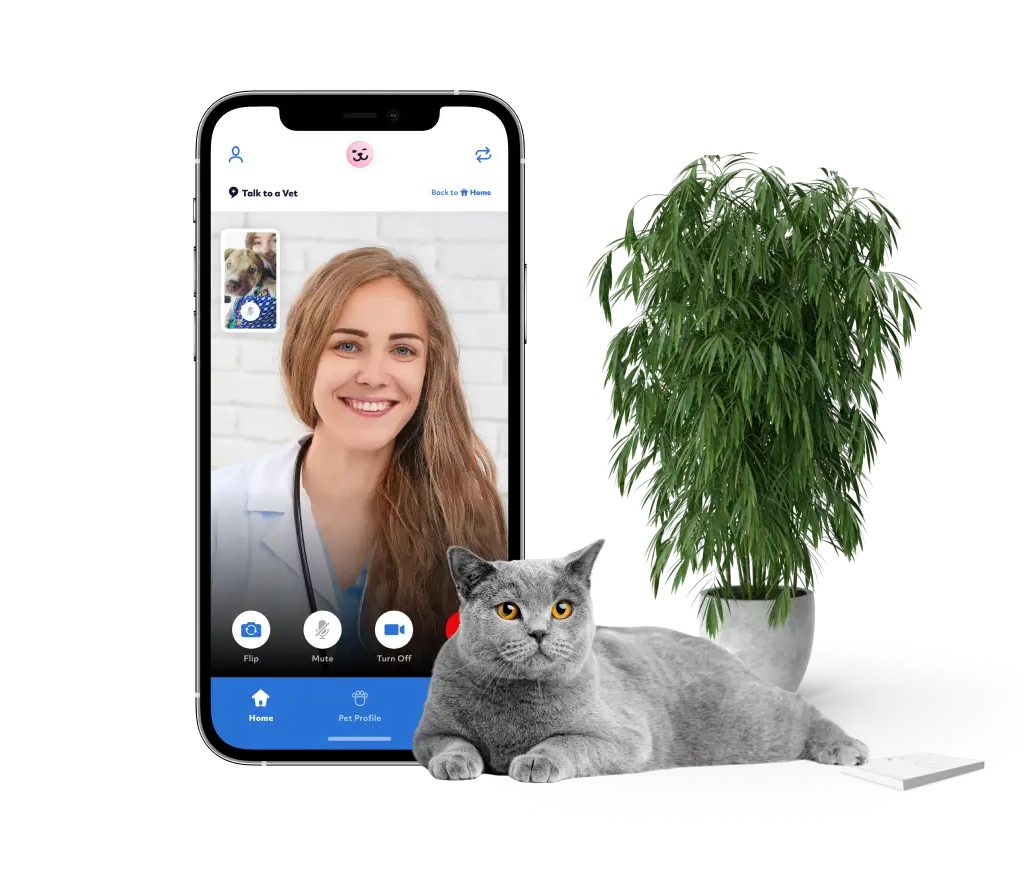If your pet is experiencing a medical emergency, an in-person visit with their regular veterinarian or a visit to a veterinary emergency clinic is typically necessary, as is an in-person visit for their annual exams, bloodwork, and vaccinations. However, in many other situations, it might be easier, more convenient, and less expensive to interact with a licensed veterinarian via a Zoom appointment. Yes, that’s right — telemedicine for dogs is here!
According to Pawp, a telehealth service for pet parents, upwards of 60 percent of all pet issues can be solved with a telehealth (as opposed to an in-person) appointment. While the concept of telemedicine (or telehealth) for humans has been around for a while, it wasn’t until the COVID-19 pandemic that people began using the video calling capabilities offered by their smartphones, tablets, and computers to communicate with their doctor(s) when in-person visits were not possible or convenient.
This same technology can now be used to communicate with a licensed veterinarian or pet expert that’s part of a telemedicine service, or in some cases, your pet’s own veterinarian.

What exactly is veterinary telemedicine?
According to Dr. Antje Joslin, an in-house veterinarian expert at Dogtopia, “Most smartphones, tablets, and laptops can provide the audio/visual capabilities to host a telemedicine consultation over various platforms, such as Zoom. The availability of telemedicine may vary quite a bit from practice to practice, as well as from state to state, based on existing mandates, but all require an existing veterinarian-client-patient relationship (VCPR), unless it’s an emergency.”
Just like when visiting a veterinarian in-person, Dr. Joslin explained, “During the telemedicine appointment, the doctor will ask pertinent history or situational questions, or may ask to see the pet during the video call. For example, if you are calling about a rash on their skin, the veterinarian you’re speaking with may have you show them the affected area. A telemedicine visit can assess whether your pet needs to be seen in person by their regular veterinarian or an emergency vet clinic, or if there is something the owner can do at home.”
Other ways veterinary telemedicine can be used, according to Dr. Joslin, is to refill prescription medications, review lab work, or check on post-surgical healing, without having to transport your pet to the veterinarian’s office. She added, “Telemedicine appointments can be used in many situations, as long as a veterinarian-client-patient relationship exists, and the doctor who is working with your pet feels they are able to assess good clinical judgment to help the patient remotely.”
While telemedicine works well in many situations, it’s not suitable for others. For example, Dr. Joslin explained that an in-person veterinary appointment is necessary when it comes to anything that obviously needs a hands-on assessment or treatment. She stated, “There’s no substitution for an in-person veterinary visit when vaccinations need to be administered, diagnostic procedures need to be conducted, a surgery needs to be performed, or if there’s an emergency situation that needs in-person attention to properly be managed.”
How to get the most out of a veterinary telemedicine appointment

When it comes to getting the most out of a telemedicine appointment with a veterinarian, there are several things you can do, in advance, as a pet parent. For starters, having two adults present during the telemedicine call will allow one person to speak with the veterinarian and hold the smartphone or tablet, for example, while the second person keeps the dog or cat calm.
Prior to the telemedicine appointment, gather a copy of your pet’s medical records, including a list of their current medications and food. Also, write down a list of any questions you want to ask the veterinarian. Next, gather, set up, and test the technology you’ll need to participate in the video call. Whenever possible, choose an area in your home that’s well lit, where you’ll be able to keep your dog calm, and that offers room to move around.
“Knowing your pet’s vaccine history, having their list of current medications on hand, and gathering as much pertinent history relating to the reason for the telemedicine visit as possible will all be beneficial,” explained Dr. Joslin, who believes that saving time and convenience are the biggest advantages that telemedicine offers. This type of veterinary appointment is also beneficial to pets that are hard to get into a clinic, due to things like anxiety, aggression, or mobility issues.
If during a telemedicine appointment the veterinarian prescribes a new medication for your pet, in some cases, that veterinarian will be able to mail you the medication, or you’ll be able to pick it up at their office at your convenience. Alternatively, you can take advantage of an online pharmacy. Chewy.com, Petco, and PetSmart, for example, each offer comprehensive online pharmacy services.
The cost of veterinary telemedicine
As for the cost associated with a telemedicine appointment with a licensed veterinarian, Dr, Joslin explained that “Some large corporate practices that have health and wellness plans where clients pay a monthly or yearly fee, will include telehealth in the service’s plans at no additional cost. In addition, some pet insurance companies provide free telehealth services to clients. Otherwise, the fee is usually equivalent to what you’d pay for an in-office visit with your local veterinarian. If you have pet insurance, contact that company to determine if the cost of telehealth services is included in your plan. Some insurance companies offer free telehealth consults just for being part of their program.”
Discover Pawp: An on-demand pet telehealth service

In addition to working with a local veterinarian and having pet insurance, subscribing to a telehealth service, like Pawp, provides telemedicine services to pet parents that are available 24/7, for a flat rate of $19.00 per month. As a Pawp subscriber, you can participate in unlimited video calls or text message conversations with licensed veterinarians and pet professionals, with no appointment or wait time required.
The Pawp experts are available, at your convenience, to help you manage your pet’s health, deal with behavioral issues, and focus on nutritional concerns whenever they arise. So, whether you’re a new pet parent dealing with a puppy’s nutritional issues for the first time, or you have an older dog that suddenly starts exhibiting unusual behavioral issues, Pawp is a place where you can get expert answers and support. In addition, a Pawp subscription includes coverage for one emergency veterinary care bill per year (up to $3,000).
Dr. Jo Myers has been a practicing clinical veterinary medicine for more than 30 years. Recently, she joined Pawp as the organization’s Lead Veterinary Advisor. She explained, “Ease, flexibility, and access are the biggest advantage of utilizing telemedicine for your pet. As a veterinarian, I can remotely meet up with pet parents and their pets in their own home, where they’re the most comfortable.”
She added, “Telemedicine is not a way to shortcut the medical system. Instead, it’s an additional way to provide access to pet patients who need to consult with a veterinary professional. In my opinion, telemedicine is ideal for dealing with preventative medical issues, addressing nutritional questions, or for troubleshooting ongoing behavioral issues, for example. We’re also able to help manage chronic medical conditions, such as allergies, via telemedicine. It’s important to understand that telemedicine is not a substitution, however, for hands-on medical care when it’s required.”
Dr. Myers also explained that the legalities pertaining to veterinary telemedicine vary from state to state, and this is not yet a service that all veterinary practices have adopted. It is, however, the wave of the future in terms of it being a new way that veterinarians to help care for their clients.
“When I first learned about Pawp as a pet parent myself, I immediately thought this was a totally different type of service and one that was definitely needed. I emailed the company, and we opened a dialog that led to me being hired by Pawp as an expert advisor. I am not actually someone a subscriber would talk to if they requested a telehealth appointment,” she said. “I love that a pet parent can log into our service anytime and get expert answers to their pet-related questions from the comfort of their home.”
Always be prepared
Dr. Myers agrees with Dr. Joslin when it comes to how pet parents should prepare for a telehealth appointment, and she stressed that being in a well-lit room will help the pet expert you’re consulting with to see your pet in the clearest way possible. She also agreed that having details about your pet’s prescriptions, current diet, and medical history will be helpful.
“At the start of each telehealth appointment, the veterinarian or pet expert you’re consulting with will ask a bunch of questions. The better you’re able to answer those questions with complete and accurate information, the easier it will be for the person you’re consulting with to provide information that’s beneficial to you and your pet,” said Dr. Myers.
She added, “There is a lot of pet-related information on the Internet, but that’s a mixed blessing because not all of it is accurate. Working with an experienced veterinarian or pet expert will make it much easier to stay informed and provide the best possible care to your pet. I do not recommend simply relying on Dr. Google when you need answers to medical questions pertaining to your pet.”
Even if you have the best veterinary experts at your fingertips thanks to telemedicine, it’s essential for pet parents to have a plan in place when an emergency arises. “Know where you can take your pet, anytime day or night if they need urgent medical care,” she added.
Additional veterinary telemedicine services
Within the United States, other services that provide telemedicine services by licensed veterinarians and related pet experts, include: Chewy, PetPro Connect, TeleTails, AirVet, and TeleVet. Visit the Apple iPhone App Store or Google Play Store (for Android smartphones) to download the mobile app associated with one of these services.



